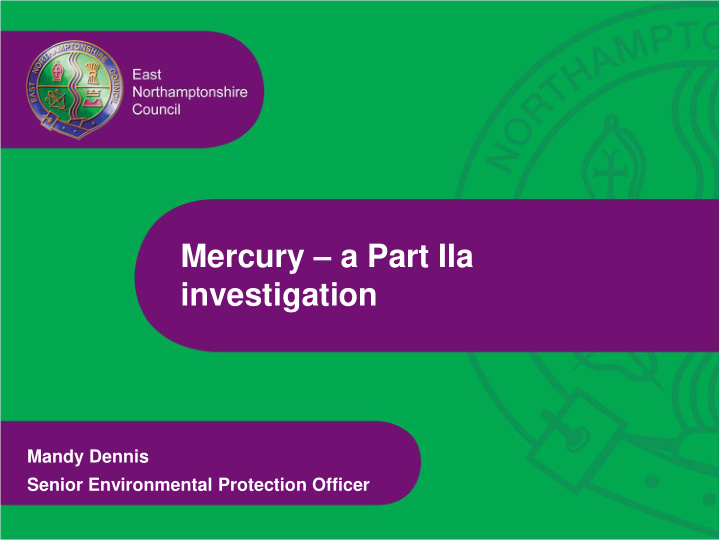



Mercury – a Part IIa investigation Mandy Dennis Senior Environmental Protection Officer
An unlikely mix!
Always expect the unexpected! Mercury (total) found across the site ranging from 0.7mg/kg to 390mg/kg Plus arsenic – naturally occurring
1884
1952
1964
• Where did it come from? • Anecdotal evidence of a tannery • Further investigation • 15 further trial pits • 32 soil samples • Mercury 2.3mg/kg to 960mg/kg • Highly leachable • Geology – Made ground over Northampton Sand and Ironstone Formation • Mercury found to depths of 2m
Site history • Tannery started between 1884 and 1900 • Closed in 1957 • Sold in 1965 and used as a garage • 2000 sold for housing
Leather finishing • Tanned leather can be dry and hard • Casein emulsion used to make leather supple and fix the dyes • Milk based casein has mercuric chloride added to it • Acts as a bactericide • Prevents the casein going off • Usage largely finished by the 1950s
What is casein? • Principle protein found in cows milk as a suspension of casein micelles • Family of phosphoproteins • Gives milk the white colour • Cheese is the coagulation of casein using rennet • Used in processed food products • Casein based glues used in woodworking and aircraft manufacture • Casein glue used to coat transformer board • Leather finishing
What next – risk assessment • Inorganic mercury • SNIFFER assessment gave SSAC of 20mg/kg • Installation of boreholes • Mercury in groundwater 83ug/l in borehole and well • Lots of discussion about compliance point • Source removed • Remediation surface strip • Clay capping layer and topsoil
Digging out hotspot
Hotspot reinstated
Why Part IIa? • Missed section of land at back of site outside footprint of the tannery had elevated levels of mercury max 50mg/kg at near surface • If mercury found here could it be in other adjoining properties around the tannery/garage 11 – 116mg/kg 0.25 – 5.9mg/kg
Part IIa investigation • 12 properties investigated • Criteria within 20 metres of site boundary • Special site based on the presence of mercury on the Northampton Sand and Ironstone formation • Investigation undertaken by the Environment Agency
Museum of Leathercraft • Kelly’s Directory 1893 list a John Lee & Son trading in the village • In the Welland list no mention of this company on either the 1849 or 1874 lists • In 1915 company name changed to John Lee & Son (Grantham) Ltd • Up to 1930s traded as furriers, hide and skin merchants • In the late 1930s hatters was added to the list • Possibly closed during war time • Known for tanning rabbit hides • Closed in 1957 possibly due to myxomatosis in rabbits
As Mad as a Hatter! • Listed as furriers up to 1930s • Late 1930s company listed as hatters • Fur from small animals used to make felt for hat making • Suggested they specialised in treating rabbit hides
Carroting! • Nothing to do with the vegetable! • Rabbit skins rinsed in a heated solution of mercuric nitrate or brushed onto the pelt • Pelts dried in an over or outside on racks • Turned the rabbit skins a carrot colour • Fur separated from the pelt put onto a cone shaped colander and treated with hot water to consolidate • Banned in US in 1941 not because of health risks but that mercury fulminate was needed to make detonators from WWII • Suggested the site was not operational during the war • Banned in UK by 1941
Carroting
Carroting
Part IIa Investigation • Investigated 12 residential properties • Criteria within 20 metres of the boundary of the tannery • Communication strategy • Involved all partners such as the PCT, HPA, GPs, etc • Consultants engaged by the Environment Agency • Sampling of gardens for all three forms of mercury • Results ranged from 8.41mg/kg to 62.4mg/kg • One garden reported levels of mercury up to 62.4mg/kg (US95 32.2mg/kg) • SSAC 11.1 – 14.2mg/kg
Further investigation
Voluntary remediation
Human health assessment criteria inorganic mercury mg/kg • ICRCL 1 • SNIFFER SSAC 20 • SGV 8 • SSAC 11.2 – 14.1 • SSAC without home grown produce 51 • SGV 170 • LQM/CIEH S4UL 40 • C4SL ND
THANK YOU FOR LISTENING Mandy Dennis Senior Environmental Protection Officer 01832 742037 mdennis@east-northamptonshire.gov.uk
Recommend
More recommend